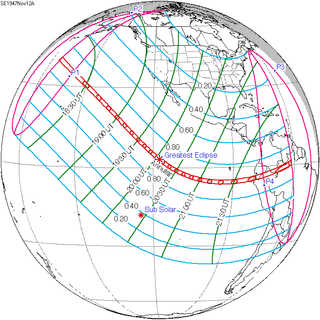| Solar eclipse of November 12, 1947 | |
|---|---|
| Type of eclipse | |
| Nature | Annular |
| Gamma | 0.3743 |
| Magnitude | 0.965 |
| Maximum eclipse | |
| Duration | 239 s (3 min 59 s) |
| Coordinates | 3°00′N 117°24′W / 3°N 117.4°W |
| Max. width of band | 135 km (84 mi) |
| Times (UTC) | |
| Greatest eclipse | 20:05:37 |
| References | |
| Saros | 132 (42 of 71) |
| Catalog # (SE5000) | 9393 |
An annular solar eclipse occurred at the Moon's descending node of orbit on Wednesday, November 12, 1947,[1] with a magnitude of 0.965. A solar eclipse occurs when the Moon passes between Earth and the Sun, thereby totally or partly obscuring the image of the Sun for a viewer on Earth. An annular solar eclipse occurs when the Moon's apparent diameter is smaller than the Sun's, blocking most of the Sun's light and causing the Sun to look like an annulus (ring). An annular eclipse appears as a partial eclipse over a region of the Earth thousands of kilometres wide. Occurring about 6.1 days before apogee (on November 18, 1947, at 23:30 UTC), the Moon's apparent diameter was smaller.[2]
Annularity was visible from the Pacific Ocean, Peru, Ecuador, Colombia and Brazil. A partial eclipse was visible for parts of Hawaii, North America, Central America, the Caribbean, and western South America.
- ^ "November 12, 1947 Annular Solar Eclipse". timeanddate. Retrieved 4 August 2024.
- ^ "Moon Distances for London, United Kingdom, England". timeanddate. Retrieved 4 August 2024.
